[English] 日本語
 Yorodumi
Yorodumi- PDB-8rrs: Structure of mouse RyR2 solubilised in detergent in open state in... -
+ Open data
Open data
- Basic information
Basic information
| Entry | Database: PDB / ID: 8rrs | ||||||||||||
|---|---|---|---|---|---|---|---|---|---|---|---|---|---|
| Title | Structure of mouse RyR2 solubilised in detergent in open state in complex with Ca2+, ATP, caffeine and Nb9657. | ||||||||||||
 Components Components |
| ||||||||||||
 Keywords Keywords | TRANSPORT PROTEIN / Ion channel / Ca2+ / tetramer | ||||||||||||
| Function / homology |  Function and homology information Function and homology informationestablishment of protein localization to endoplasmic reticulum / type B pancreatic cell apoptotic process / Purkinje myocyte to ventricular cardiac muscle cell signaling / regulation of atrial cardiac muscle cell action potential / left ventricular cardiac muscle tissue morphogenesis / suramin binding / regulation of AV node cell action potential / regulation of SA node cell action potential / Stimuli-sensing channels / regulation of ventricular cardiac muscle cell action potential ...establishment of protein localization to endoplasmic reticulum / type B pancreatic cell apoptotic process / Purkinje myocyte to ventricular cardiac muscle cell signaling / regulation of atrial cardiac muscle cell action potential / left ventricular cardiac muscle tissue morphogenesis / suramin binding / regulation of AV node cell action potential / regulation of SA node cell action potential / Stimuli-sensing channels / regulation of ventricular cardiac muscle cell action potential / ventricular cardiac muscle cell action potential / positive regulation of sequestering of calcium ion / embryonic heart tube morphogenesis / cardiac muscle hypertrophy / Ion homeostasis / calcium ion transport into cytosol / ryanodine-sensitive calcium-release channel activity / response to caffeine / response to redox state / release of sequestered calcium ion into cytosol by sarcoplasmic reticulum / cellular response to caffeine / calcium ion transmembrane import into cytosol / response to muscle activity / protein kinase A regulatory subunit binding / protein kinase A catalytic subunit binding / positive regulation of the force of heart contraction / intracellularly gated calcium channel activity / smooth endoplasmic reticulum / detection of calcium ion / regulation of cardiac muscle contraction by regulation of the release of sequestered calcium ion / positive regulation of heart rate / response to muscle stretch / cellular response to epinephrine stimulus / calcium channel complex / sarcoplasmic reticulum membrane / regulation of heart rate / sarcoplasmic reticulum / sarcomere / establishment of localization in cell / calcium-mediated signaling / calcium ion transmembrane transport / calcium channel activity / Z disc / intracellular calcium ion homeostasis / calcium ion transport / calmodulin binding / response to hypoxia / calcium ion binding / protein kinase binding / enzyme binding / protein-containing complex / identical protein binding / membrane Similarity search - Function | ||||||||||||
| Biological species |   | ||||||||||||
| Method | ELECTRON MICROSCOPY / single particle reconstruction / cryo EM / Resolution: 3.4 Å | ||||||||||||
 Authors Authors | Li, C. / Efremov, R.G. | ||||||||||||
| Funding support |  Belgium, European Union, 3items Belgium, European Union, 3items
| ||||||||||||
 Citation Citation |  Journal: J Biol Chem / Year: 2024 Journal: J Biol Chem / Year: 2024Title: Rapid small-scale nanobody-assisted purification of ryanodine receptors for cryo-EM. Authors: Chenyao Li / Katrien Willegems / Tomasz Uchański / Els Pardon / Jan Steyaert / Rouslan G Efremov /  Abstract: Ryanodine receptors (RyRs) are large Ca release channels residing in the endoplasmic or sarcoplasmic reticulum membrane. Three isoforms of RyRs have been identified in mammals, the disfunction of ...Ryanodine receptors (RyRs) are large Ca release channels residing in the endoplasmic or sarcoplasmic reticulum membrane. Three isoforms of RyRs have been identified in mammals, the disfunction of which has been associated with a series of life-threatening diseases. The need for large amounts of native tissue or eukaryotic cell cultures limits advances in structural studies of RyRs. Here, we report a method that utilizes nanobodies to purify RyRs from only 5 mg of total protein. The purification process, from isolated membranes to cryo-EM grade protein, is achieved within 4 h on the bench, yielding protein usable for cryo-EM analysis. This is demonstrated by solving the structures of rabbit RyR1, solubilized in detergent, reconstituted into lipid nanodiscs or liposomes, and bovine RyR2 reconstituted in nanodisc, and mouse RyR2 in detergent. The reported method facilitates structural studies of RyRs directed toward drug development and is useful in cases where the amount of starting material is limited. | ||||||||||||
| History |
|
- Structure visualization
Structure visualization
| Structure viewer | Molecule:  Molmil Molmil Jmol/JSmol Jmol/JSmol |
|---|
- Downloads & links
Downloads & links
- Download
Download
| PDBx/mmCIF format |  8rrs.cif.gz 8rrs.cif.gz | 3.3 MB | Display |  PDBx/mmCIF format PDBx/mmCIF format |
|---|---|---|---|---|
| PDB format |  pdb8rrs.ent.gz pdb8rrs.ent.gz | Display |  PDB format PDB format | |
| PDBx/mmJSON format |  8rrs.json.gz 8rrs.json.gz | Tree view |  PDBx/mmJSON format PDBx/mmJSON format | |
| Others |  Other downloads Other downloads |
-Validation report
| Summary document |  8rrs_validation.pdf.gz 8rrs_validation.pdf.gz | 1.5 MB | Display |  wwPDB validaton report wwPDB validaton report |
|---|---|---|---|---|
| Full document |  8rrs_full_validation.pdf.gz 8rrs_full_validation.pdf.gz | 1.8 MB | Display | |
| Data in XML |  8rrs_validation.xml.gz 8rrs_validation.xml.gz | 400.8 KB | Display | |
| Data in CIF |  8rrs_validation.cif.gz 8rrs_validation.cif.gz | 632.2 KB | Display | |
| Arichive directory |  https://data.pdbj.org/pub/pdb/validation_reports/rr/8rrs https://data.pdbj.org/pub/pdb/validation_reports/rr/8rrs ftp://data.pdbj.org/pub/pdb/validation_reports/rr/8rrs ftp://data.pdbj.org/pub/pdb/validation_reports/rr/8rrs | HTTPS FTP |
-Related structure data
| Related structure data |  19463MC 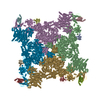 8rrtC  8rruC 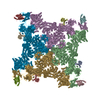 8rrvC 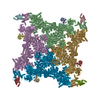 8rrwC 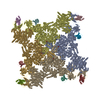 8rrxC  8rs0C M: map data used to model this data C: citing same article ( |
|---|---|
| Similar structure data | Similarity search - Function & homology  F&H Search F&H Search |
- Links
Links
- Assembly
Assembly
| Deposited unit | 
|
|---|---|
| 1 |
|
- Components
Components
-Protein / Antibody , 2 types, 8 molecules ACEFBDGI
| #1: Protein | Mass: 565536.000 Da / Num. of mol.: 4 / Source method: isolated from a natural source / Source: (natural)  #2: Antibody | Mass: 15125.495 Da / Num. of mol.: 4 Source method: isolated from a genetically manipulated source Source: (gene. exp.)   |
|---|
-Non-polymers , 4 types, 16 molecules 
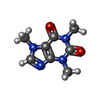





| #3: Chemical | ChemComp-ATP / #4: Chemical | ChemComp-CFF / #5: Chemical | ChemComp-ZN / #6: Chemical | ChemComp-CA / |
|---|
-Details
| Has ligand of interest | Y |
|---|---|
| Has protein modification | Y |
-Experimental details
-Experiment
| Experiment | Method: ELECTRON MICROSCOPY |
|---|---|
| EM experiment | Aggregation state: PARTICLE / 3D reconstruction method: single particle reconstruction |
- Sample preparation
Sample preparation
| Component |
| ||||||||||||||||||||||||
|---|---|---|---|---|---|---|---|---|---|---|---|---|---|---|---|---|---|---|---|---|---|---|---|---|---|
| Source (natural) |
| ||||||||||||||||||||||||
| Source (recombinant) | Organism:  | ||||||||||||||||||||||||
| Buffer solution | pH: 7.4 | ||||||||||||||||||||||||
| Specimen | Embedding applied: NO / Shadowing applied: NO / Staining applied: NO / Vitrification applied: YES | ||||||||||||||||||||||||
| Vitrification | Cryogen name: ETHANE |
- Electron microscopy imaging
Electron microscopy imaging
| Microscopy | Model: JEOL CRYO ARM 300 |
|---|---|
| Electron gun | Electron source:  FIELD EMISSION GUN / Accelerating voltage: 300 kV / Illumination mode: SPOT SCAN FIELD EMISSION GUN / Accelerating voltage: 300 kV / Illumination mode: SPOT SCAN |
| Electron lens | Mode: BRIGHT FIELD / Nominal defocus max: 2500 nm / Nominal defocus min: 1500 nm |
| Image recording | Electron dose: 60 e/Å2 / Film or detector model: GATAN K3 (6k x 4k) |
- Processing
Processing
| EM software |
| ||||||||||||||||||||||||||||||
|---|---|---|---|---|---|---|---|---|---|---|---|---|---|---|---|---|---|---|---|---|---|---|---|---|---|---|---|---|---|---|---|
| Image processing | Details: The movies were selected after MotionCor correction and CTF refinement with the parameters: total drift less than 30 angstrom and resolution better than 5 angstrom | ||||||||||||||||||||||||||||||
| CTF correction | Type: PHASE FLIPPING AND AMPLITUDE CORRECTION | ||||||||||||||||||||||||||||||
| Particle selection | Num. of particles selected: 791664 Details: Particles were picked by template picking in Cryosparc | ||||||||||||||||||||||||||||||
| 3D reconstruction | Resolution: 3.4 Å / Resolution method: FSC 0.143 CUT-OFF / Num. of particles: 76852 / Symmetry type: POINT |
 Movie
Movie Controller
Controller
























 PDBj
PDBj









